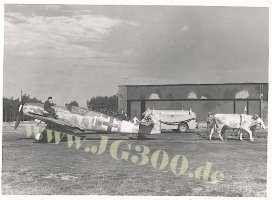
Me 109G-6/AS Wnr.: 165693 mit rotem RVB?
neue Bilder bei eBay aufgetaucht!

Me 109G6-AS mit rotem RVB?
A few years ago following pictures were assigned to the JG300. The photographs are made definitely in the summer to earlyinherit 1944 in Jüterbog, in this time also the III./ JG300 was stationed.
In the book of Lorant's “Jagdgeschwader 300” Vol.I is maintained to the fact that these pictures of departures come from orthochromatic film. We doubted from the outset. Therefore we asked photo experts in a forum. They gave us already-willingly information.
- Das heißt, daß Rot nicht belichtet, also schwarz erscheint. Es sei denn, bei Aufnahmen im Freien, wenn die rote Farbe ultraviolett reflektiert. Aus Sicht des gesunden Menschenverstandes erscheint das unwahrscheinlich, weil Rot am anderen Ende des Spektrums liegt. ....
- Also: nicht belichtet (rot) bedeutet auf dem Negativ keine Schwärzung, also im Positiv schwarz. Eben nicht belichtet. Schwarz entsteht ja auch bei panchromatischen Filmen durch Mangel an Licht.
- Knallgrün und Knallrot haben den gleichen Helligkeitswert für einen panchromatischen SW-Film. Wenn keinerlei Filter benutz wurden, versteht sich. Dagegen unterscheiden sich Grün u. Rot bei einem orthochromatischen Film sehr.
- Rotfilter, Orangefilter: dramatische Himmelsabdunklung mit starker Hervorhebung der Wolken, Abdunklung von Grünzeug, bei rot stärker als bei orange.
- Gelbfilter (der häufigst verwendete): Abdunklung des Himmels mit Wolkenbetonung, aber etwas weniger dramatisch im Effekt, bei hellem Grünzeug leichte Aufhellung desselben. Wurde bei einfachen Kameras auch zur Empfindlichkeitsreduzierung vor die Linse geschwenkt bei Einstellung "Sonne"
- Grünfilter: ergibt einen kontrastolsen Himmel, dafür wird das Grünzeug deutlich heller und bekommt sehr abwechslungsreiche Graustufen mit schöner Durchzeichnung und Unterschieden zwischen den einzelnen Grüntönen
Quotation: “A orthochromatic emulsion is sensitively for light each wavelength of the visible electromagnetic spectrum (plus ultraviolets) except for the color red.”
- That is, that red does not expose, it appears thus black. It is, with photographs in the free one, if the red color reflects ultraviolet. From view of the healthy human understanding that appears improbable, because red is because of the other end of the spectrum. ….
- Thus: not exposed (red) no density means, thus in the positive black on the negative. Evenly does not expose. Black results also with panchromatic films from lack of light.
- Bang-green and bang-red have the same brightness value for a panchromatischen bw-film. If no filter use became, understands itself. On the other hand green and red differ with a orthochromatic film much.
Effect of filters with panchromatic material:
- Red filter, Orange filter: dramatic sky darkening with strong emphasis of the clouds, darkening of greens, at the red light more strongly than with orange.
- Yellow filter (more used): Darkening the sky with stronged cloud, but somewhat less dramatically in the effect, with bright greens lower clarification of the same. With simple cameras also for sensitivity reduction before the lens swivelled during attitude “sun”
- Green filter: results in a kontrastolsen sky, but the greens become clearly brighter and get very varied gray tones with beautiful contrast and differences between the individual green tones

Jüterbog/ Altes Lager
JG300 Maschinen in Wartung
Bei Ebay tauchten Ende Dezmber 2024 neue Bilder von der bereits oben abgebildeten roten "1" der I./ JG300 auf. Für über 250.-€ gingen diese Bilder an einen Käufer weg, unverschämt teuer!
Ich habe die Verkaufsobjekte zur Sicherung hier gesammelt und zeige wenigstens diese. Auch hier handelt es sich um orthochromatisches Filmmaterial, das weiße Rumpfband ist ROT!!
Interessant ist die Ar-96, die warscheinlich auch dem JG300 zuzusprechen ist. Eine solche Maschine taucht auch in den Verlustlisten des JG300 auf!






